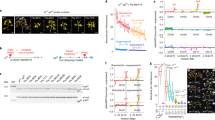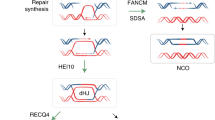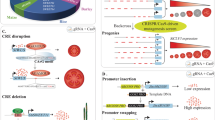Abstract
Breeding of crops over millennia for yield and productivity1 has led to reduced genetic diversity. As a result, beneficial traits of wild species, such as disease resistance and stress tolerance, have been lost2. We devised a CRISPR–Cas9 genome engineering strategy to combine agronomically desirable traits with useful traits present in wild lines. We report that editing of six loci that are important for yield and productivity in present-day tomato crop lines enabled de novo domestication of wild Solanum pimpinellifolium. Engineered S. pimpinellifolium morphology was altered, together with the size, number and nutritional value of the fruits. Compared with the wild parent, our engineered lines have a threefold increase in fruit size and a tenfold increase in fruit number. Notably, fruit lycopene accumulation is improved by 500% compared with the widely cultivated S. lycopersicum. Our results pave the way for molecular breeding programs to exploit the genetic diversity present in wild plants.
This is a preview of subscription content, access via your institution
Access options
Access Nature and 54 other Nature Portfolio journals
Get Nature+, our best-value online-access subscription
$29.99 / 30 days
cancel any time
Subscribe to this journal
Receive 12 print issues and online access
$209.00 per year
only $17.42 per issue
Buy this article
- Purchase on Springer Link
- Instant access to full article PDF
Prices may be subject to local taxes which are calculated during checkout



Similar content being viewed by others
References
Evans, L.T. Crop Evolution, Adaptation and Yield (Cambridge Univ. Press, 1996).
van de Wouw, M., Kik, C., van Hintum, T., van Treuren, R. & Visser, B. Genetic erosion in crops: concept, research results and challenges. Plant Genet. Resour. 8, 1–15 (2010).
Food and Agriculture Organization of the United Nations. FAO Statistical Yearbook 2015: World Food and Agriculture (United Nations, 2015).
Lippman, Z. & Tanksley, S.D. Dissecting the genetic pathway to extreme fruit size in tomato using a cross between the small-fruited wild species Lycopersicon pimpinellifolium and L. esculentum var. Giant Heirloom. Genetics 158, 413–422 (2001).
Gruber, K. Agrobiodiversity: the living library. Nature 544, S8–S10 (2017).
Meyer, R.S. & Purugganan, M.D. Evolution of crop species: genetics of domestication and diversification. Nat. Rev. Genet. 14, 840–852 (2013).
Cˇermák, T. et al. A multipurpose toolkit to enable advanced genome engineering in plants. Plant Cell 29, 1196–1217 (2017).
Falke, K.C. et al. The spectrum of mutations controlling complex traits and the genetics of fitness in plants. Curr. Opin. Genet. Dev. 23, 665–671 (2013).
Zsögön, A., Cermak, T., Voytas, D. & Peres, L.E.P. Genome editing as a tool to achieve the crop ideotype and de novo domestication of wild relatives: case study in tomato. Plant Sci. 256, 120–130 (2017).
Pnueli, L. et al. The SELF-PRUNING gene of tomato regulates vegetative to reproductive switching of sympodial meristems and is the ortholog of CEN and TFL1. Development 125, 1979–1989 (1998).
Liu, J., Van Eck, J., Cong, B. & Tanksley, S.D. A new class of regulatory genes underlying the cause of pear-shaped tomato fruit. Proc. Natl. Acad. Sci. USA 99, 13302–13306 (2002).
Xu, C. et al. A cascade of arabinosyltransferases controls shoot meristem size in tomato. Nat. Genet. 47, 784–792 (2015).
Frary, A. et al. Fw2.2: a quantitative trait locus key to the evolution of tomato fruit size. Science 289, 85–88 (2000).
Lippman, Z.B. et al. The making of a compound inflorescence in tomato and related nightshades. PLoS Biol. 6, e288 (2008).
Ronen, G., Carmel-Goren, L., Zamir, D. & Hirschberg, J. An alternative pathway to β-carotene formation in plant chromoplasts discovered by map-based cloning of beta and old-gold color mutations in tomato. Proc. Natl. Acad. Sci. USA 97, 11102–11107 (2000).
Rick, C.M. The tomato. Sci. Am. 239, 76–87 (1978).
Peet, M.M. Fruit cracking in tomato. Horttechnology 2, 216–223 (1991).
Cong, B., Barrero, L.S. & Tanksley, S.D. Regulatory change in YABBY-like transcription factor led to evolution of extreme fruit size during tomato domestication. Nat. Genet. 40, 800–804 (2008).
Tieman, D. et al. A chemical genetic roadmap to improved tomato flavor. Science 355, 391–394 (2017).
Römer, S. et al. Elevation of the provitamin A content of transgenic tomato plants. Nat. Biotechnol. 18, 666–669 (2000).
Clinton, S.K. Lycopene: chemistry, biology, and implications for human health and disease. Nutr. Rev. 56, 35–51 (2009).
Bramley, P.M. Is lycopene beneficial to human health? Phytochemistry 54, 233–236 (2000).
Lenucci, M.S., Cadinu, D., Taurino, M., Piro, G. & Dalessandro, G. Antioxidant composition in cherry and high-pigment tomato cultivars. J. Agric. Food Chem. 54, 2606–2613 (2006).
Kuti, J.O. & Konuru, H.B. Effects of genotype and cultivation environment on lycopene content in red-ripe tomatoes. J. Sci. Food Agric. 85, 2021–2026 (2005).
Adalid, A.M., Roselló, S. & Nuez, F. Evaluation and selection of tomato accessions (Solanum section Lycopersicon) for content of lycopene, β-carotene and ascorbic acid. J. Food Compos. Anal. 23, 613–618 (2010).
Ashrafi, H., Kinkade, M.P., Merk, H.L. & Foolad, M.R. Identification of novel quantitative trait loci for increased lycopene content and other fruit quality traits in a tomato recombinant inbred line population. Mol. Breed. 30, 549–567 (2012).
Liu, Y.-S. There is more to tomato fruit colour than candidate carotenoid genes. Plant Biotechnol. J. 1, 195–207 (2003).
Li, C. et al. RNA-guided Cas9 as an in vivo desired-target mutator in maize. Plant Biotechnol. J. 15, 1566–1576 (2017).
Soyk, S. et al. Bypassing negative epistasis on yield in tomato imposed by a domestication gene. Cell 169, 1142–1155.e12 (2017).
Doebley, J.F., Gaut, B.S. & Smith, B.D. The molecular genetics of crop domestication. Cell 127, 1309–1321 (2006).
Doebley, J., Stec, A. & Hubbard, L. The evolution of apical dominance in maize. Nature 386, 485–488 (1997).
Studer, A., Zhao, Q., Ross-Ibarra, J. & Doebley, J. Identification of a functional transposon insertion in the maize domestication gene tb1. Nat. Genet. 43, 1160–1163 (2011).
Moreno, M.A., Harper, L.C., Krueger, R.W., Dellaporta, S.L. & Freeling, M. liguleless1 encodes a nuclear-localized protein required for induction of ligules and auricles during maize leaf organogenesis. Genes Dev. 11, 616–628 (1997).
Wang, H., Studer, A.J., Zhao, Q., Meeley, R. & Doebley, J.F. Evidence that the origin of naked kernels during maize domestication was caused by a single amino acid substitution in tga1. Genetics 200, 965–974 (2015).
Yang, Q. et al. CACTA-like transposable element in ZmCCT attenuated photoperiod sensitivity and accelerated the postdomestication spread of maize. Proc. Natl. Acad. Sci. USA 110, 16969–16974 (2013).
Huang, C. et al. ZmCCT9 enhances maize adaptation to higher latitudes. Proc. Natl. Acad. Sci. USA 115, E334–E341 (2018).
Tian, Z. et al. Artificial selection for determinate growth habit in soybean. Proc. Natl. Acad. Sci. USA 107, 8563–8568 (2010).
Cai, Y. et al. CRISPR/Cas9-mediated targeted mutagenesis of GmFT2a delays flowering time in soya bean. Plant Biotechnol. J. 16, 176–185 (2018).
Lu, X. et al. The transcriptomic signature of developing soybean seeds reveals the genetic basis of seed trait adaptation during domestication. Plant J. 86, 530–544 (2016).
Dong, Y. et al. Pod shattering resistance associated with domestication is mediated by a NAC gene in soybean. Nature Commun. 5, 3352 (2014).
Pino, L.E. et al. The Rg1 allele as a valuable tool for genetic transformation of the tomato 'Micro-Tom' model system. Plant Methods 6, 23 (2010).
Murashige, T. & Skoog, F. A revised medium for rapid growth and bio assays with tobacco tissue cultures. Physiol. Plant. 15, 473–497 (1962).
Tomato Genome Consortium. The tomato genome sequence provides insights into fleshy fruit evolution. Nature 485, 635–641 (2012).
Sérino, S., Gomez, L., Costagliola, G. & Gautier, H. HPLC assay of tomato carotenoids: validation of a rapid microextraction technique. J. Agric. Food Chem. 57, 8753–8760 (2009).
Acknowledgements
We are grateful to S. Schültke for technical assistance. This work was supported by funding from the Agency for the Support and Evaluation of Graduate Education (CAPES, Brazil), the National Council for Scientific and Technological Development (CNPq, Brazil) and Foundation for Research Assistance of the São Paulo State (FAPESP, Brazil), and the German Federal Ministry of Education and Research (BMBF, Germany). We thank CAPES for studentships granted to E.R.N. and FAPESP for the studentship granted to M.M.N. (2013/12209-1). L.F. was supported by FAPESP grant 2013/18056-2. FAPESP and BMBF provided a grant for L.E.P.P. (2015/50220-2) and J.K. (031B0334). L.E.P.P. acknowledges a grant from CNPq (grant 307040/2014-3).
Author information
Authors and Affiliations
Contributions
A.Z., T.C., D.F.V., J.K. and L.E.P.P. designed the study. A.Z., T.C., M.M.N., E.R.N., K.H.E., S.W. and L.F. performed experiments. A.Z., T.C. and K.H.E. analyzed data. A.Z., K.H.E., J.K. and L.E.P.P. prepared the manuscript. All authors have revised and approved the final version of the manuscript.
Corresponding authors
Ethics declarations
Competing interests
After completion of this work in the laboratory of D.F.V., T.C. became an employee of Inari Agriculture, a company that uses novel technologies for crop breeding. D.F.V. is a founder and Chief Science Officer of Calyxt, a company applying genome editing to plants.
Supplementary information
Supplementary Text and Figures
Supplementary Figures 1–11 (PDF 16905 kb)
Supplementary Tables
Supplementary Tables 1–12 (PDF 1582 kb)
Supplementary Note 1
Annotated sequence for pTC321 (TXT 57 kb)
Supplementary Note 2
Annotated sequence for pTC603 (TXT 41 kb)
Supplementary Dataset 1
Raw sequence files and alignments corresponding to Supplementary Figure 2 and Supplementary Tables 3 and 5 (ZIP 53625 kb)
Supplementary Dataset 2
Raw sequence files and alignments corresponding to Figures 1–3, Supplementary Figures 3, 4, 5 and 7, and Supplementary Table 2 (ZIP 37477 kb)
Rights and permissions
About this article
Cite this article
Zsögön, A., Čermák, T., Naves, E. et al. De novo domestication of wild tomato using genome editing. Nat Biotechnol 36, 1211–1216 (2018). https://doi.org/10.1038/nbt.4272
Received:
Accepted:
Published:
Issue Date:
DOI: https://doi.org/10.1038/nbt.4272
This article is cited by
-
Comparison of Cas12a and Cas9-mediated mutagenesis in tomato cells
Scientific Reports (2024)
-
How CRISPR could yield the next blockbuster crop
Nature (2024)
-
Genetic gains underpinning a little-known strawberry Green Revolution
Nature Communications (2024)
-
Trans situ conservation strategies to conserve the extinction risk species, Sesamum prostratum Retz., a crop wild relative of sesame being endemic to coastal strand habitat: a case study
Genetic Resources and Crop Evolution (2024)



